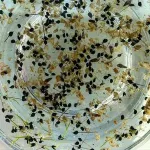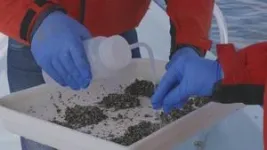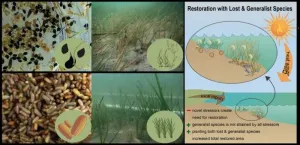(Press-News.org) What do the flow of cars on a highway and the movement of bacteria towards a food source have in common? In both cases, annoying traffic jams can form. Especially for cars, we might want to understand how to avoid them, but perhaps we've never thought of turning to statistical physics, as Alexandre Solon, a physicist from Sorbonne Université, and Eric Bertin, from the University of Grenoble, both working for the Centre national de la recherche scientifique CNRS, have done. Their research, recently published in the Journal of Statistical Mechanics: Theory and Experiment (JSTAT), has developed a one-dimensional mathematical model that describes the movement of particles in situations similar to cars moving along a road or bacteria attracted to a nutrient source, which they then tested with computer simulations to observe what happened as parameters varied.
"The model is one-dimensional because the elements can only move in one direction, like on a one-lane one-way street," explains Solon. It's an idealized situation, but not so different from what happens on many roads where you can find yourself stuck in rush hour traffic. The models from which this research is derived historically come from studying the behavior of atoms and molecules, for example, those in a gas being heated or cooled. In the case of Bertin and Solon’s model, however, the behavior of the individual elements is a bit more sophisticated than that of an atom. "Among other things, a component of inertia has been inserted, which can be more or less pronounced, replicating for example the reactivity of a driver at the wheel. We can imagine a fresh and reactive driver, who brakes and accelerates at just the right moments, or another one at the end of the day, more tired and struggling to stay in sync with the rhythm of the flow of cars they are in," Solon explains.
By conducting simulations with different values of certain parameters (the density of the elements, inertia, speed), Solon and Bertin were able to determine both situations in which traffic flowed smoothly or, on the contrary, became congested, as well as the type of jams that formed: large and centralized, or smaller and distributed along the route, akin to a "stop-and-go" pattern.
Borrowing language from statistical mechanics, Solon speaks of phase transitions: "just as when the temperature changes water becomes ice, when the values of some parameters change, a smooth flow of cars becomes a congestion, a knot where no movement is possible." When the system reaches a critical density or when movement conditions favor accumulation rather than dispersion, the particles begin to form dense clusters, similar to traffic jams, while other areas may remain relatively empty. Traffic jams, therefore, can be seen as the dense phase in a system that has undergone a phase transition, characterized by low mobility and high localization of particles.
Solon and Bertin have thus identified conditions that can favor this congestion. Continuing with the metaphor of cars, contributing to the formation of traffic jams is the high density of vehicles, which reduces the space between one vehicle and another and increases the likelihood of interaction (and thus slowdown). Another condition is the frequent entries and exits from the flow: the addition of vehicles from the access ramp or attempts to change lanes in dense areas increase the risk of slowdowns, especially if vehicles try to merge without leaving sufficient space. A third factor is the already mentioned inertia in the behavior of drivers, who, when they react with some delay to changes in the speed of the vehicles ahead of them, create a chain reaction of braking that can lead to the formation of a traffic jam. In contrast the aggregation observed in bacterial colony happens in absence of any inertia and bacteria can move in any direction contrary to cars that need to follow the direction of traffic. As Éric Bertin says " it is thus interesting and surprising to find that both types of behaviors are connected and can be continuously transformed into one another."
END
Cars as particles
Traffic jams explained with statistical physics
2024-04-30
ELSE PRESS RELEASES FROM THIS DATE:
Let widgeongrass be a weed in the seagrass yard -- making seagrass restoration more resistant to rising temperatures using generalist grasses
2024-04-30
New research demonstrates that seagrass habitat restoration can be enhanced by including other grasses in addition to the declining or lost species and – ultimately – that restoration efforts must proactively select species that can withstand current and intensifying stressors driven by human activities and climate change.
Rising global temperatures combined with centuries of humans working within our seascapes has reshaped coastal ecosystems. Rebuilding or restoring coastal habitat is becoming ...
Group sales incentives boost weak brand sales, study finds
2024-04-30
New research co-authored by a UC Riverside business professor provides some sound advice for managers of retail outlets that limit their product selection to a particular brand: Managers should factor in the strength of their brand when structuring the pay incentives for their sales staff.
The study focused on what marketing scholars call “brand-managed” retail operations. These outlets include “stores within stores,” such as counters in major department stores with dedicated sales staff that offer just one brand of cosmetics such as Clinique. They can also be stores ...
The double-fanged adolescence of saber-toothed cats
2024-04-30
The fearsome, saber-like teeth of Smilodon fatalis — California's state fossil — are familiar to anyone who has ever visited Los Angeles' La Brea Tar Pits, a sticky trap from which more than 2,000 saber-toothed cat skulls have been excavated over more than a century.
Though few of the recovered skulls had sabers attached, a handful exhibited a peculiar feature: the tooth socket for the saber was occupied by two teeth, with the permanent tooth slotted into a groove in the baby tooth.
Paleontologist Jack Tseng, associate professor of integrative biology at the University of California, Berkeley, doesn't think the double fangs ...
COVID-19-induced financial hardships reveal mental health struggles
2024-04-30
When COVID-19 caused significant economic disruptions, thousands of people around the world experienced sudden shocks to their financial situation through reduced earnings or job losses.
Now economic researchers at the University of South Australia have examined the mental health effects on people who experienced immediate or expected financial setbacks during the height of the pandemic.
Data gathered from China, Japan and South Korea during the early phases of the pandemic revealed that the severe economic shocks induced by COVID-19 caused significant ...
Healthy lifestyle may offset effects of life-shortening genes by 60%+
2024-04-30
A healthy lifestyle may offset the effects of life-shortening genes by more than 60%, suggests an analysis of the findings from several large long term studies, published online in the journal BMJ Evidence Based Medicine.
While genes and lifestyle seem to have an additive effect on a person’s lifespan, an unhealthy lifestyle is independently linked to a 78% heightened risk of dying before one’s time, regardless of genetic predisposition, the research indicates.
The polygenic risk score (PRS) combines ...
Frequent teen vaping might boost risk of toxic lead and uranium exposure
2024-04-30
Frequent teen vaping might boost the risk of exposure to lead and uranium, potentially harming brain and organ development, suggests research published online in the journal Tobacco Control.
The findings underscore the need for implementation of regulations and prevention efforts targeting teens, emphasise the researchers.
Vaping is popular with teens. In 2022, an estimated 14% of US high school students—around 2.14 million—and more than 3% of middle school students—around 380,000—reported vaping in the preceding month, note the researchers.
Certain metals have been identified in e-cigarette aerosols and ...
Fentanyl inhalation may cause potentially irreversible brain damage, warn doctors
2024-04-30
Inhaling the synthetic opioid fentanyl may cause potentially irreversible brain damage (toxic leukoencephalopathy), warn doctors in the journal BMJ Case Reports, after treating a middle aged man found unresponsive in his hotel room after snorting the drug.
Leukoencephalopathy refers to inflammation and damage to the brain’s white matter—the network of nerve fibres that enable the exchange of information and communication between different areas of the brain’s grey matter.
Toxic leukoencephalopathy is a sudden or longstanding neurological syndrome, which ...
OHSU patient is world’s first documented case of brain disease from fentanyl inhalation
2024-04-30
The man arrived unconscious and near death.
Previously healthy with no known medical history, the 47-year-old arrived by ambulance to the emergency department at Oregon Health & Science University on Feb. 25, 2023. He was found collapsed in his hotel room, where he was staying during a business trip. As clinicians began administering life-saving treatment, they searched for the cause.
In a case report published online today in the journal BMJ Case Reports, clinicians laid out the surprising and unprecedented diagnosis: toxic ...
Microarray patches safe and effective for vaccinating children, trial shows
2024-04-30
EMBARGOED UNTIL 23:30 UK TIME MONDAY 29 APRIL 2024
Peer-reviewed/Randomised Control Trial/Humans
The phase 1/2 randomized trial compared results from the measles and rubella vaccine delivered by a microarray patch, a small sticking plaster-like device with an array of microscopic projections that painlessly penetrate the skin and deliver the vaccine, or by conventional injection with a needle and syringe.
The trial, which involved 45 adults (18-40 years old), 120 toddlers (15-18 months old) and 120 infants (9-10 months old) in The Gambia, ...
Montana State scientists’ research on RNA editing illuminates possible lifesaving treatments for genetic diseases
2024-04-30
BOZEMAN – A team at Montana State University published research this week that shows how RNA, the close chemical cousin to DNA, can be edited using CRISPRs. The work reveals a new process in human cells that has potential for treating a wide variety of genetic diseases.
Postdoctoral researchers Artem Nemudryi and Anna Nemudraia conducted the research alongside Blake Wiedenheft, professor in the Department of Microbiology and Cell Biology in MSU’s College of Agriculture. The paper, titled “Repair of CRISPR-guided RNA breaks enables site-specific RNA excision ...
LAST 30 PRESS RELEASES:
Tracing the quick synthesis of an industrially important catalyst
New software sheds light on cancer’s hidden genetic networks
UT Health San Antonio awarded $3 million in CPRIT grants to bolster cancer research and prevention efforts in South Texas
Third symposium spotlights global challenge of new contaminants in China’s fight against pollution
From straw to soil harmony: International team reveals how biochar supercharges carbon-smart farming
Myeloma: How AI is redrawing the map of cancer care
Manhattan E. Charurat, Ph.D., MHS invested as the Homer and Martha Gudelsky Distinguished Professor in Medicine at the University of Maryland School of Medicine
Insilico Medicine’s Pharma.AI Q4 Winter Launch Recap: Revolutionizing drug discovery with cutting-edge AI innovations, accelerating the path to pharmaceutical superintelligence
Nanoplastics have diet-dependent impacts on digestive system health
Brain neuron death occurs throughout life and increases with age, a natural human protein drug may halt neuron death in Alzheimer’s disease
SPIE and CLP announce the recipients of the 2025 Advanced Photonics Young Innovator Award
Lessons from the Caldor Fire’s Christmas Valley ‘Miracle’
Ant societies rose by trading individual protection for collective power
Research reveals how ancient viral DNA shapes early embryonic development
A molecular gatekeeper that controls protein synthesis
New ‘cloaking device’ concept to shield sensitive tech from magnetic fields
Researchers show impact of mountain building and climate change on alpine biodiversity
Study models the transition from Neanderthals to modern humans in Europe
University of Phoenix College of Doctoral Studies releases white paper on AI-driven skilling to reduce burnout and restore worker autonomy
AIs fail at the game of visual “telephone”
The levers for a sustainable food system
Potential changes in US homelessness by ending federal support for housing first programs
Vulnerability of large language models to prompt injection when providing medical advice
Researchers develop new system for high-energy-density, long-life, multi-electron transfer bromine-based flow batteries
Ending federal support for housing first programs could increase U.S. homelessness by 5% in one year, new JAMA study finds
New research uncovers molecular ‘safety switch’ shielding cancers from immune attack
Bacteria resisting viral infection can still sink carbon to ocean floor
Younger biological age may increase depression risk in older women during COVID-19
Bharat Innovates 2026 National Basecamp Showcases India’s Most Promising Deep-Tech Ventures
Here’s what determines whether your income level rises or falls
[Press-News.org] Cars as particlesTraffic jams explained with statistical physics





